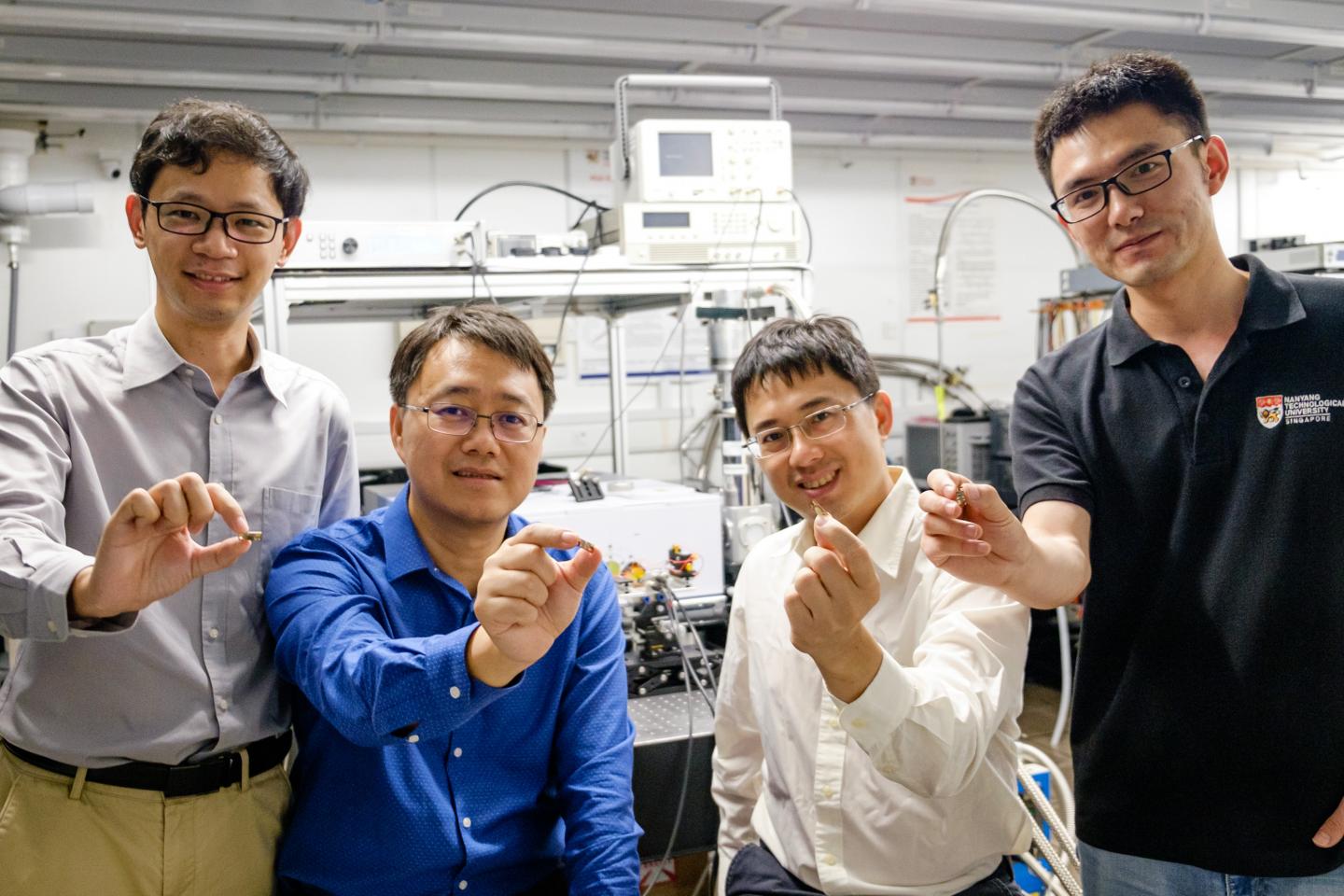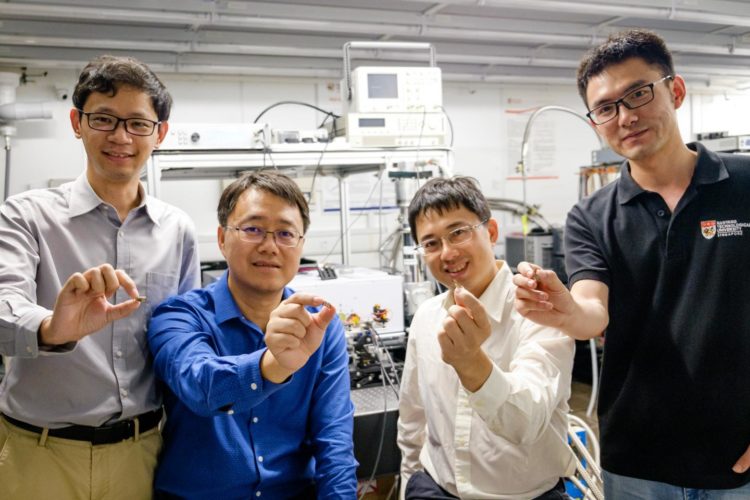
Credit: NTU Singapore
Scientists and engineers from Nanyang Technological University, Singapore (NTU Singapore) and the University of Leeds in the UK have created the first electrically-driven ‘topological’ laser, which has the ability to route light particles around corners – and to cope with defects in the manufacture of the device.
Electrically-driven semiconductor lasers are the most common type of laser device today. They are used in products such as barcode readers and laser printers, for fibre optic communications, and in emerging applications such as laser ranging sensors for self-driving cars.
However, their manufacture is an exacting process and current laser designs do not work well if any defects are introduced into the structure of the laser during these processes.
The Singapore-UK advance reported in Nature today (12 February) overcomes this long-standing problem and promises to lead to more efficient and less wasteful manufacturing using existing semiconductor technologies. This is accomplished by harnessing a concept from theoretical physics known as the topological states, in order to make a ‘topological laser’.
In the 1980s scientists found that electrons flowing in certain materials have ‘topological features’ – meaning that they can flow around corners or imperfections without scattering or leaking. The 2016 Nobel Prize in Physics was awarded to three theoretical physicists who pioneered the study of such topological states of electrons.
Now, an interdisciplinary team of engineers and physicists from NTU Singapore in collaboration with material scientists from the University of Leeds, have applied this topological approach to light particles, known as photons.
“Every batch of manufactured laser devices has some fraction that fails to emit laser light due to imperfections introduced during fabrication and packaging,” said Professor Qi Jie Wang, the lead scientist from NTU Singapore’s School of Electrical and Electronic Engineering. “This was one of our motivations for exploring topological states of light, which are much more robust than ordinary light waves.”
In the present study, the researchers worked with a type of electrically-driven laser called a quantum cascade laser, based on advanced semiconductor wafers developed at the University of Leeds.
A senior author of the study, Professor Giles Davies FREng, Pro-Dean for Research and Innovation in the Faculty of Engineering and Physical Sciences at the University of Leeds, said: “The topological laser is a great example of a fascinating fundamental scientific phenomenon being applied to a practical electronic device, and as our study shows, it has the potential to improve the performance of laser systems.”
To achieve topological states on a laser platform, the NTU and Leeds team developed a new design containing a valley photonic crystal, which was inspired by electronic topological materials known as two-dimensional valleytronic insulators.
The design consists of hexagonal holes arranged in a triangular lattice, etched into a semiconductor wafer, making it extremely compact.
Within the microstructure, the topological states of light circulate within a triangular loop of 1.2 millimetre circumference, acting as an optical resonator to accumulate the light energy required to form a laser beam.
“The fact that light circulates in this loop, including going around the sharp corners of the triangle, is due to the special features of topological states,” says Associate Professor Yi Dong Chong, a theoretical physicist in NTU Singapore’s School of Physical and Mathematical Sciences and co-lead investigator of the project. “Ordinary light waves would be disrupted by the sharp corners, preventing them from circulating smoothly.”
The researchers note that an interesting feature of the new topological quantum cascade laser is that the light it emits is at terahertz frequencies between the microwave and infrared regions of the electromagnetic spectrum. Terahertz light has been identified as one of the principal realms from which future technological applications in sensing, illumination, and wireless communications may emerge.
This research project spanned two years, and involved an interdisciplinary team of twelve researchers. Team members also include NTU physicists: Associate Professor Baile Zhang, postdoctoral research fellow and first author of the paper, Dr Yongquan Zeng; as well as Professor Edmund Linfield, Professor of Terahertz Electronics, and Dr Lianhe Li, Senior Research Fellow, both at Leeds.
Looking ahead, the joint team is working on lasers that make use of other types of topological states.
“The design we used in this project, called a valley photonic crystal, is not the only way to create topological states,” Professor Wang said. “There are many different types of topological states, imparting protection against different kinds of imperfections. We think it will be possible to tailor the design to the needs of different devices and applications.”
In 2018, a team at the Technion – Israel Institute of Technology and the University of Central Florida in the USA developed a topological laser made from an array of connected optical resonators. The researchers showed that the topological states of light could travel efficiently around corners and defects in the laser array. However, this prototype laser had the drawback of being much larger than most semiconductor lasers, as well as being ‘optically driven’, meaning that it was powered by another laser.
###
The research at the University of Leeds was funded by the UK’s Engineering and Physical Sciences Research Council.
Notes to Editor:
Paper titled “Electrically Pumped Topological Laser with Valley Edge Modes”, published in Nature, 12 Feb 2020.
Media contacts:
Lester Kok
Assistant Director
Corporate Communications Office
Nanyang Technological University
Tel: +65 6790 6804
Email: [email protected]
David Lewis
Media Officer,
University of Leeds
Tel: +44 (0) 113 343 2049
Email: [email protected]
About Nanyang Technological University, Singapore
A research-intensive public university, Nanyang Technological University, Singapore (NTU Singapore) has 33,000 undergraduate and postgraduate students in the Engineering, Business, Science, Humanities, Arts, & Social Sciences, and Graduate colleges. It also has a medical school, the Lee Kong Chian School of Medicine, set up jointly with Imperial College London.
NTU is also home to world-class autonomous institutes – the National Institute of Education, S Rajaratnam School of International Studies, Earth Observatory of Singapore, and Singapore Centre for Environmental Life Sciences Engineering – and various leading research centres such as the Nanyang Environment & Water Research Institute (NEWRI) and Energy Research Institute @ NTU (ERI@N).
Ranked 11th in the world, NTU has been placed the world’s top young university for the past six years. The NTU Smart Campus is frequently listed among the Top 15 most beautiful university campuses in the world and it has 57 Green Mark-certified (equivalent to LEED-certified) building projects, of which 95% are certified Green Mark Platinum. Apart from its main campus, NTU also has a campus in Novena, Singapore’s healthcare district.
For more information, visit http://www.
University of Leeds
The University of Leeds is one of the largest higher education institutions in the UK, with more than 38,000 students from more than 150 different countries, and a member of the Russell Group of research-intensive universities. The University plays a significant role in the Turing, Rosalind Franklin and Henry Royce Institutes and hosts the Bragg Centre which aims to discover, create and design new materials.
We are a top ten university for research and impact power in the UK, according to the 2014 Research Excellence Framework, and are in the top 100 of the QS World University Rankings 2020. Additionally, the University was awarded a Gold rating by the Government’s Teaching Excellence Framework in 2017, recognising its ‘consistently outstanding’ teaching and learning provision. Twenty-six of our academics have been awarded National Teaching Fellowships – more than any other institution in England, Northern Ireland and Wales – reflecting the excellence of our teaching.
Over a third of our academics are involved in applied research or as consultants to industry, and over the last ten years, the University of Leeds has produced more than 100 ‘spin-out’ companies.
http://www.
Media Contact
Lester Kok
[email protected]
65-679-06804





